THE HISTORY OF BLANCPAIN
THE HISTORY OF BLANCPAIN
THE HISTORY OF BLANCPAIN
Create successful ePaper yourself
Turn your PDF publications into a flip-book with our unique Google optimized e-Paper software.
IN TIME<br />
watchmaker, registering that profession on<br />
the village rolls. This is indeed fortunate<br />
since it is unlikely that he would be celebrated<br />
more than 270 years later had his cattle<br />
monopolised his fancy. Later, Jehan-Jacques<br />
would add a fourth profession to his resume,<br />
serving as mayor of the commune.<br />
There is somewhat of a confession to be<br />
made at this point. Since the early 1980s<br />
Blancpain has frequently honored its founding<br />
by Jehan-Jacques Blancpain as of 1735,<br />
as indeed it should, because that well establishes<br />
that Blancpain is the oldest watch<br />
company in the world. However, in celebrating<br />
its pedigree and paying homage to<br />
Jehan-Jacques, a portrait of a distinguishedlooking<br />
bearded gentlemen has been held<br />
out as his. Indeed that portrait is of a Blancpain<br />
family member, just not Jehan-Jacques;<br />
it is of Frédéric-Emile Blancpain who lived<br />
fully a century and half later. There is some<br />
relief in the discovery of this error, because,<br />
without the correction, the subject of the<br />
painting would have been one of history’s<br />
most avant-garde dressers, wearing clothes<br />
not destined to appear until more than 100<br />
years later.<br />
The 1735 date merits examination as well.<br />
It is almost certainly the case that Jehan-<br />
Jacques began watchmaking before 1735.<br />
The citation to the 1735 date is grounded<br />
upon Jehan-Jacques recordation of his occupation<br />
as “horloger” on an official property<br />
registry for the Villeret commune that year.<br />
VILLERET CIRCA 1850.<br />
To identify himself as a watchmaker as of<br />
that date, he must have been practising the<br />
craft for some period before.<br />
Blancpain fairly lays claim to being the oldest<br />
watch company in the world, because<br />
although Jehan-Jacques was not the first<br />
watchmaker in the world, for that one must<br />
go back hundreds of years earlier, the brand<br />
he pioneered has been continuously active<br />
since at least 1735 through to today.<br />
Although our history has a long distance to<br />
traverse before reaching the 1980s, it is well<br />
at this juncture to correct the record a second<br />
time. In the 1980s, several story variants<br />
were floated – that Blancpain had gone out<br />
of existence, that Blancpain had been in<br />
bankruptcy, that Blancpain had ceased operations<br />
– to embellish a portrayal of rebirth<br />
during that decade. In fact, none of these<br />
stories was true. As our tale unfolds we will<br />
see continuity in one form or another from<br />
the official recording of Jehan-Jacques<br />
Blancpain as a watchmaker in 1735 through<br />
to the present day. Jehan-Jacques, thus, was<br />
the founder of what is now the world’s oldest<br />
watch company.<br />
We can safely surmise that Jehan-Jacques<br />
Blancpain approached his craft in similar<br />
fashion as his compatriots in the Villeret<br />
commune, that is to say as a family enterprise.<br />
It was the custom of the time for both<br />
husbands and wives to work together to<br />
produce watches. Generally the men devoted<br />
themselves to cutting and forming the<br />
plates and bridges, fashioning<br />
the wheels and pinions, regulation<br />
of the time-keeping<br />
and encasement of the<br />
movements. Women were<br />
the finishing specialists –<br />
polishing and decorating<br />
components.<br />
The Blancpain watchmaking<br />
family circle soon<br />
came to include many.<br />
Jehan-Jacques’ son, Isaac,<br />
followed in his father’s<br />
footsteps both as a watchmaker<br />
and a school teacher,<br />
joining with uncles and aunts,<br />
also watchmakers.<br />
The Blancpains adhered to Villeret<br />
custom which considered labelling<br />
watches with a name to be both vain and<br />
unbecomingly commercial, preferring instead<br />
to sell their wares absent a trademark.<br />
This discretion in their method of selling<br />
deprives us of virtually all evidence of their<br />
early work. The sole remaining trace of the<br />
Blancpain family’s pre-1800 efforts which<br />
has been located is a Louis XVI inner watch<br />
back signed “Blancpain et fils”. Notwithstanding<br />
this absence today of signed pieces<br />
from this epoch, it is known that David-Louis<br />
Blancpain (1765-1816), grandson of Jehan-<br />
Jacques, cast his sights beyond the borders<br />
of Switzerland, travelling to European commercial<br />
centres selling Blancpain family







